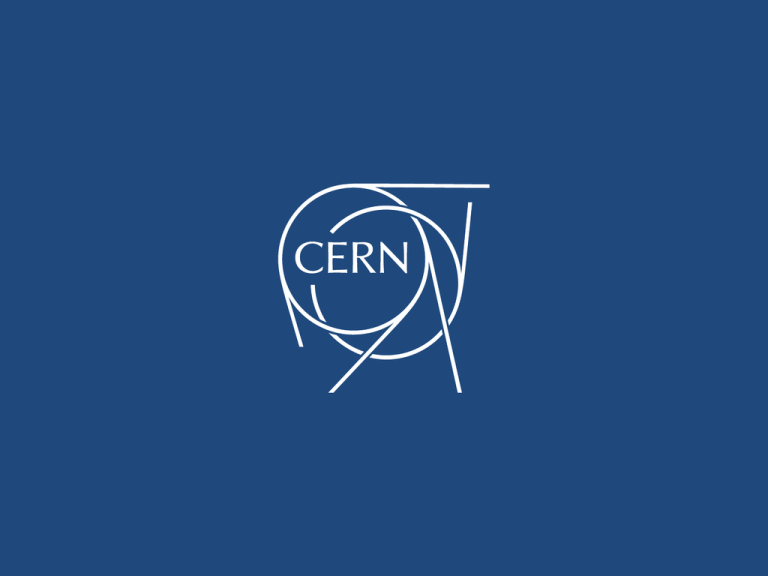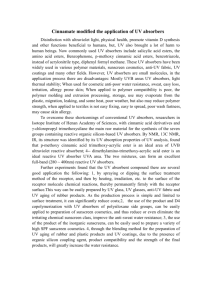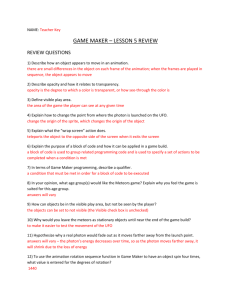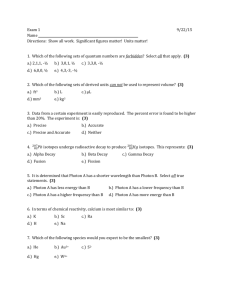FCC-ee_22nd_Meeting_7Dec2015 - Indico
advertisement

FCC-e: A Ray-Tracing Study of Discrete Photon Absorbers, Pros and Cons R. Kersevan CERN-TE-VSC-VSM 07/12/2015 2 • At the TLEP workshops no. 4 and 6 the different versions of the FCC-ee accelerator have already been discussed in terms of SR spectra, flux, power and their linear and surfacic densities (see bonus slides) • Vacuum-wise, the most challenging is the Z-pole machine at 45.5 GeV, due to its extremely large beam current, 1450 mA; The ttbar (T) version is challenging in terms of SR power density (extreme vertical collimation of SR fan) Outgassing: • Under the assumption of a large bending radius and no lumped absorber (à-la LEP) the specific outgassing rate Q(mbar · l/s/m) is related to the linear photon flux F(ph/s/m) by the formula: Q=h·F·k • where h is the photon-induced desorption (PID) rate (mol/ph) and k is a conversion factor (mbar·l/mol), k=4.05E-20 (@ 20 °C). • The linear photon flux is: F = 8.08E+17 · E(GeV) · I(mA) / (2pr) , with r = 9791.21 m; for FCC-ee Z, F = 5.3E+22/ (2pr) = 5.3E+22/ 6.16E+4 = 8.6E+17 (ph/s/m) • This leads to Q = h · 8.6E+17 · 4.05E-20 = h · 3.48E-2 (mbar*l/s/m) • h varies over several orders of magnitude (~1E-2 ~1E-7): it depends on the material, cleaning procedures, surface finish, any eventual coatings, bake-out temperature, and most of all it depends on the integrated photon dose (ph/m) at a given location (determined by the geometry of the vacuum chamber and any photon absorbers, accounting for photon scattering) • For a given/needed average pressure along the ring, dictated by machine-physics issues, such as beam-gas scattering lifetime, beam-loss and related energy deposition, e-cloud (for the e+ beam), etc… it is therefore important to get as quickly as possible a low h • This reduction can be obtained by collecting the photon flux on short absorbers (like done on most modern light sources), and installing near the absorbers as much pumping speed as possible (compatibly with conductance limitations) • To improve things even further, NEG-coating would be beneficial, as it possesses an intrinsically low PID yield (>2 orders of magnitude lower than un-coated surface) • NEG-coating would also be beneficial in reducing the e-cloud in the e+ ring • Other possibility is given by TiN-coating, as employed on a large scale at KEK-B and SuperKEKB as well, although TiN does not give a PID yield reduction, and therefore needs to have some sort of effective pumping installed along with it. Same for aCarbon Pumping: • Lumped pumping (number of pumps depending on the conductance of the vacuum chamber) can be prohibitively expensive for a 100 km-long machine • Distributed pumping can be implemented only via NEG-strips (like LEP did), as the magnetic field of the dipoles is too weak for implementing distributed ion-pumps (like the US B-Factory did for the high-energy ring, or CESR at Cornell) • Distributed pumping can also be obtained by applying NEG-coating (like in the LHC’s LSSs) • The advantage of distributed pumping vs lumped pumping is that the former does not depend on the conductance of the chamber, while the latter does • In-situ bake-out is highly recommended, and probably necessary in order to obtain rapidly a low-Z residual gas composition. It is mandatory in case of NEG-coating Conceptual proposal: • Based on the considerations outlined above, a conceptual design has been proposed which implements localized SR absorbers (to speed-up the conditioning time and minimize photon scattering) • Another important feature of the localized absorbers is that they allow concentrating the Compton-scattered flux (especially for the very-high energy machines), which could constitute a potential source of activation in the tunnel and damage to any sensitive electronic equipment, in addition to the formation of ozone and related corrosion (see L. Lari’s presentation at 6th TLEP Workshop, and F. Cerutti at FCC KickOff, Univ. Geneva) • The proposed cross-section of the vacuum chamber is elliptical, 90x30 mm2 (HxV) • The material of choice is copper, 2 mm-thick (C. Garion, TE-VSC, has checked its mechanical fitness under bake-out conditions: OK) • Aluminium could also be a choice, but it is much more transparent to penetrating gamma rays, possibly requiring additional distributed shielding (like LEP). Aluminium has also a higher PID as compared to copper, in case of non-NEG-coated chamber • The interconnecting space between dipoles and between dipoles and quadrupoles has been used to install SR photon absorbers (with heavy shielding), bellows, BPMs, pumping ports, flanges, connections for water cooling of the chambers/absorbers, and the necessary anchoring fixed points, as schematized below: FODO Cell – V16 (B.Harer, CERN) Q Half-Cell S S D 0.15 m D 10.0 m S Q 1.5 m S Q D D 0.775 m 0.65 m 0.5 m 50 m D = Dipole, L = 10 m Q = Quadrupole, L = 1.5 m S = Sextupole, L =0.5 m Total number of dipoles: 2x 6152 Courtesy: B. Harer Interconnections BQ and QB (conceptual, dimensions subject to change) Coils: 10 cm Coils: 5 cm Flanges : 5 cm Coils: 15 cm Coils: 5 cm Coils: 15 cm Flanges : 5 cm Coils: 10 cm Absorber: 30 cm bellows : 5 cm (25 + 2*12.5) BPM: 20 cm Pumping port / valve: 15 cm bellows : 9 cm (65 + 2*12.5) IC BQ: ~ 55 cm IC BQ: ~ 65 cm Courtesy: C. Garion Half cell (conceptual, dimensions subject to change) 15 cm 65 cm 55 cm 65 cm L_interconnection: 185 cm (coils extremities included) Courtesy: C. Garion Photon ray-tracing: 175 Gev tt vs 45.5 GeV Z: EARLY MODEL… • 30 cm-long V-shaped absorbers (Cu or GlidCop); One placed inside each 10m-long dipole, plus 1 in the 0.65m-long dipole-dipole IC and 1 in the IC BQ (or IC QB) • The photon flux of the Z-machine is >50 times higher than that of tt! Photon ray-tracing: 175 Gev tt vs 45.5 GeV Z: NEW MODEL, with bellows, tapers, BPMs • • • • More detailed model: 3x bellows with larger ID tapered sections (for BPMs) Position of SR absorbers is optimized ~100% of DIRECT SR fan collected on abs Tips of V-shaped SR absorbers 24 mm from beam axis; Height of ABSs: +/- 7.5 mm SR linear power and flux densities: • LEP (45~100 GeV): 1.82~9.0 W/mA/m vs FCC-ee (45.5~175 GeV): 0.63~137.7 • LEP (45~100 GeV): 1.78E+15~4.1E+15 ph/s/mA/m vs FCC-ee (45.5-175 GeV): 5.55E+14~2.25E+15 Photodesorption yield for different materials Pressure profiles for different materials and pumping configurations Conclusions and to-do list: • For one ½-arc-cell of FCC-ee (lattice V.16) it is possible to collect all of the primary SR photons on four 30 cmlong, V-shaped absorbers, strategically placed • The 4 absorbers should be placed one in each of the two 10 m-long dipoles, one in the 0.65 m-long dipoledipole drift, and one in the 4.35 m-long quadrupole/sextupole drift • The linear power densities are comparable to those presently run at high-energy SR light sources: ~ 5 kW along 15 cm vs ~ 8 kW over 14 cm for the crotch absorber of the 6 GeV, 200 mA ESRF • The only issue needed optimization of the design is the vertical power density, which is extremely high for the 175 GeV FCC-ee. A combination of vertical and horizontal inclination on the absorber should be implemented • Detailed MC simulations show that there is a clear advantage in collecting all primary photons on 4x absorbers rather than letting the photon fan hit the external side of the elliptical chamber (like LEP did), as the conditioning time necessary to obtain a given pressure is much shorter • The same simulations show also that copper should be preferred to aluminium for its superior shielding power (mainly Compton scattering at higher-than-Z beam energies). In addition, Al is known to have a higher photoninduced desorption rate as compared to Cu • NEG coatings are shown to be superior to LEP-like distributed pumping with NEG-strips in an antechamber • NEG coating are also much better then non-NEG-coated surfaces in terms of photo-electron yields and multipacting, especially for the e+ ring and the related e-cloud effects To do: • evaluation of the various impedance effects and contributions (resistive, NEG, and geometric, V-shaped absorbers) for the different beam energies and currents • Similar calculations/optimization of the booster • Ask FLUKA team to re-do calculations for assessing the shielding effectiveness of the 4x absorbers with local massive shielding vs no absorbers and distributed shielding (like LEP) BONUS SLIDES Update on TLEP Vacuum Design • • Conductances, Pressure Profiles 90x30 mm2 elliptical cross-section Deformed shape under vacuum (copper) A minimum thickness of 2 and 4 mm is considered for copper and aluminium, respectively. Cross section Von Mises stress field under vacuum 30 90 6th TLEP Workshop – CERN – 16-18 October 2013 R. Kersevan - CERN – TE-VSC-IVM 17 Update on TLEP Vacuum Design • • • • Conductances, Pressure Profiles The specific conductance of a 90x30 mm2 elliptical cross-section is 53.23 l*m/s In a uniform cross-section tube with uniform outgassing, a regular pump spacing of L meters will decrease the installed pumping speed Sinst via the well known equation Seff = (1/Sinst+L/12/Cspec)-1 It doesn’t pay to install large pumps,as the conductance will “kill” the pumping speed! 1000 l/s pumps spaced ~ 11m apart will give only a ~53 l/s effective speed 6th TLEP Workshop – CERN – 16-18 October 2013 R. Kersevan - CERN – TE-VSC-IVM 18 Update on TLEP Vacuum Design • • Vacuum Conditioning Time The photodesorption yield data measured for copper (previous figure) are fitted and used to find the “conditioning time at full nominal current ” for the 3 versions of TLEP and, for reference, for the ESRF IMPORTANT NOTE: This is valid for SR hitting uniformly the vacuum chamber wall, with lumped absorbers after each dipole the photon dose (ph/m) “accelerates” by a factor of ~ 11! • Example: in order to get to eta=1.0E-3 mol/ph, one would have to fill the ring at nominal current for 130k sec for TLEP-t, 46k sec for TLEP-h, 1600 sec for TLEP-z, vs 300 sec for the ESRF dipole 6th TLEP Workshop – CERN – 16-18 October 2013 R. Kersevan - CERN – TE-VSC-IVM 19 Update on TLEP Vacuum Design • Behaviour of the pressure in LEP and LEP-2 vs beam energy and SR power (N. Hilleret, CAS Vacuum 2006) 6th TLEP Workshop – CERN – 16-18 October 2013 R. Kersevan - CERN – TE-VSC-IVM 20







